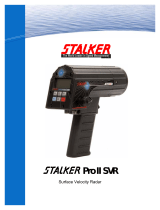Page is loading ...

BR-3501
User Manual

Warning
Based on the recommendations of the National Council on Radiation Protection and Measurements
(NCRP) in occupational/controlled situations, continued exposure to radiation should be avoided within
1 meter in front of the radar. Radiation levels outside this region fall within regulations of 5 mW/cm2 (for
periods less than 6 minutes) and are not considered safety hazards. Direct visual contact with the radar
when transmitting should be avoided at all times.
Specifications
Installation
The BR-3501 radar system includes the following three components:
Radar antenna
Tripod
Tripod mounting adapter
Before attempting to install your radar, you should familiarize yourself with your new tripod and under-
stand how the mounting adapter can be secured in place to hold the radar.
Installation Steps:
Adjust your tripod to a convenient height and orientation.
Install the tripod mounting adapter under the base of the radar.
Mount the radar on the tripod ensuring that the mounting adapter is properly locked in place.
Adjust the radar height, tilt and inclination to your needs using the tripod controls.
Operating Frequency 35 GHz
Transmitting Power 100 mW
Antenna Gain 30 dBi
Transmitter Stability ±0.1%
Beam Width 4° x 4°
Side Lobes -24 dB
Weight 12 Kg
!

Operation
The BR-3501 rear panel contains only three components:
Power/Signal Connector
The BR-3501 is interfaced to a processing unit using a single six-wire cable equipped with military
connectors. This cable is used to provide power to the antenna, to carry the radar doppler signal to the
processing unit and to carry the antenna transmission control. You should connect your radar cable from
this connector to the appropiate radar input on your processing unit.
The connector type is ITT Cannon MS3124E16-8P. The following table discribes the pinout of this
connector:
The remote activation of the transmitter can be achieved by short circuiting pins D and E of the connec-
tor.
Transmitter Switch
The transmitter switch controls the state of the radar transmitter. When set to On, the radar will transmit
the radar signal. When set to Remote, the radar will not actually transmit until the system is armed. The
armed state is controlled by the processing unit via the Power/Signal cable.
Gain Adjustment Knob
Depending on the type of projectile being tested, the amplitude of the return signal may vary greatly. Just
think of the returned signal of a 155mm projectile versus the returned signal of a 2mm fragment. Typical
Doppler processing units have a minimum dynamic range of 72 dB . The gain adjustment allows you to
control the level of amplification applied to the returned signal before it is output to a processing unit.
The gain adjustment knob provides nine (9) gain levels ranging from 10 dB up to 90 dB. Having control
over the gain allows you to avoid very strong signals from being amplified outside the supported dy-
namic range which would lead to a loss of information when processing. Similarly, it allows you to
maximize the gain applied to a very weak signal returned by a small projectile.
Pin Function
A AC Neutral
B 110 Volts AC
C Not Connected
D Remote Make (+ 5 Vdc Output)
E Make Ground
F Doppler Signal + (5 Vpp max.)
G Doppler Signal - (5 Vpp max.)
H Ground
/


